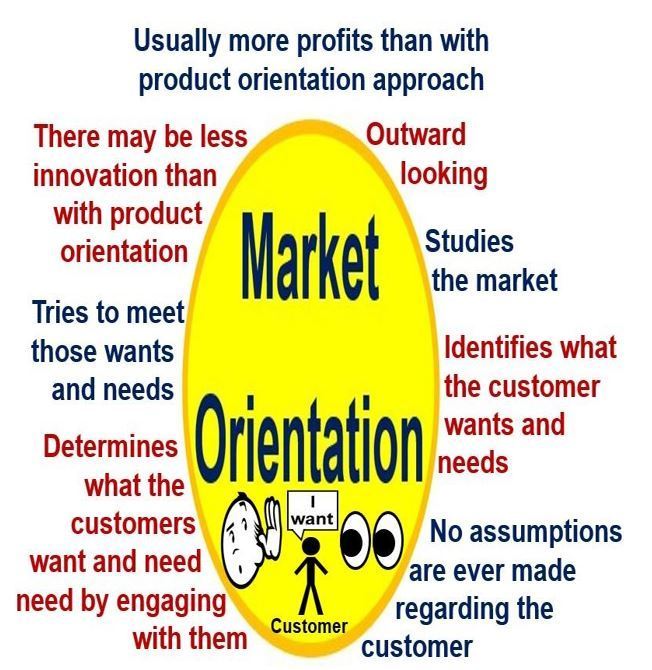Difference Product Orientation and Market Orientation
In the line of business, marketing focus decisions are inevitable. While many marketing strategies can be used in a company, they should be in line with the company goals, structure, and capabilities. Through the help of business strategists, business persons can choose between market orientation, product orientation, production orientation, and sales orientation. This should be done after understanding what each marketing strategy entails, and how the market will respond to it. Although the concepts are closely related, they have differences.

Product Orientation
This is a company’s focus on a product which ensures maximum effort is put on quality and optimum performance of a product. The company heavily invests in product development and research, ensuring the product sells itself and believes that as long as the product is high-quality people would consume such a product. It, however, does not focus on what the customers need. To achieve this, fundamental tools used include:
- Product research
- Product testing
- Product focus
Advantages of using this strategy include:
- Costs that would have been used in determining customer preferences are eliminated
- It allows a company to put full focus on a product hence delivering nothing but quality
- Since a company is only focusing on a specific product, the production process simplified
Disadvantages include:
- A company may be phased out if a competitor with the same product focuses on consumer needs
- Obsolescence of products through a change in technology and other market factors can lead to the downfall of a company
- A company using this approach misses on many market opportunities to exploit
Examples of companies that use this strategy include Ford Motor Company and Gillette Company.

Market Orientation
This is a business culture that focuses on the satisfaction of the customer. The business ensures that its values, norms, behavior alongside with the set systems, structures and control within the organization are in line with customer’s needs, hence the reaction is based on what a customer wants.
Market orientation focuses on:
- What customers want
- Building and maintaining relationships with customers
- Tracking information used for evaluation and research
- Linking customers’ needs to organizational capabilities
To achieve this, the tools used are:
- Market research
- Market testing
- Customer focus.
Advantages of using this method include;
- Promotes brand loyalty through customer satisfaction
- Impractical ideas suggested by consumers may form a basis of long term business development strategy
- Production is flexible as it is based on customer tastes and need
However, it has disadvantages including:
- It involves high costs due to market research
- There is a constant internal change which may be disruptive
- It involves a lot of future unpredictability
Similarities between Product Orientation and Market Orientation
- Both are marketing structures
Differences between Product Orientation and Market Orientation
Definition
Product orientation is a marketing approach whereby a company focuses on a product hence maximum effort is put on quality and optimum performance of a product. On the other hand, market orientation is a business culture that focuses on the satisfaction of the customer.
Focus
While product orientation fully focuses on the quality of a product, market orientation fully focuses on customer needs and satisfaction.
Organizational goal
An organization using the product orientation strategy aims at developing quality products that will attract consumers. On the other hand, an organization using the market orientation strategy aims at understanding consumers’ needs and attending to the needs in the best possible way hence satisfying the customers.
Tools used
The tools used in product orientation include product research, product testing and product focus. On the other hand, the tools used in market orientation include market research, market testing and customer focus.
Advantages
Advantages of using the product orientation strategy include the elimination of costs that would have been used in determining customer preferences, allows a company to put full focus on a product hence delivering nothing but quality, and the simplification of the production process simplified. On the other hand, advantages of using the market orientation strategy include the promotion of brand loyalty through customer satisfaction, the possibility of long term business development strategy through the use of impractical ideas suggested by consumers and flexibility in production.
Disadvantages
Disadvantages of the product orientation strategy include the phasing out of a company in instances where a competitor with the same product focuses on consumer needs, products may become absolute through a change in technology and other market factors and can lead to many missed market opportunities to exploit. On the other hand, disadvantages of the market orientation strategy include high costs involved in market research, a constant internal change which may be disruptive and future unpredictability.
Product Orientation vs. Market Orientation: Comparison Table

Summary of Product Orientation vs. Market Orientation
While product orientation is a marketing approach whereby a company focuses on a product hence maximum effort is put on quality and optimum performance of a product, market orientation is a business culture that focuses on the satisfaction of the customer. Understanding each marketing strategy is important before focusing on one. While most businesses are moving towards the market orientation strategy, it is important to have a mix of both.
- Difference Between Profit Center and Investment Center - July 2, 2022
- Difference Between Anti-Trust and Anti-Competition - June 6, 2022
- Difference Between Stocktaking and Stock Control - June 6, 2022
Search DifferenceBetween.net :
Leave a Response
References :
[0]Image credit: https://www.flickr.com/photos/davegray/6373321029
[1]Image credit: https://i1.wp.com/marketbusinessnews.com/wp-content/uploads/2017/02/Market-Orientation.jpg?fit=652%2C670&ssl=1
[2]Image credit: Diana Luck. Assessing the Marketing Environment. Routledge Publishers, 2008. https://books.google.co.ke/books?id=V--vZqLiPK0C&pg=PA45&dq=similarities+between+product+orientation+and+Market+orientation&hl=en&sa=X&ved=0ahUKEwiC-62liqrkAhWGYcAKHaayBmEQ6AEILDAB#v=onepage&q=similarities%20between%20product%20orientation%20and%20Market%20orientation&f=false
[3]Knut Holt. Market Oriented Product Innovation: A Key to Survival in the Third Millennium. Springer Science & Business Media Publishers, 2002. https://books.google.co.ke/books?id=CzuTHbIFyZQC&pg=PA10&dq=similarities+between+product+orientation+and+Market+orientation&hl=en&sa=X&ved=0ahUKEwiC-62liqrkAhWGYcAKHaayBmEQ6AEIRDAF#v=onepage&q=similarities%20between%20product%20orientation%20and%20Market%20orientation&f=false
[4]Samli A. International Consumer Behavior: It’s Impact on Marketing Strategy Development. Greenwood Publishing Group, 1995. https://books.google.co.ke/books?id=sM6_PhZ4plIC&pg=PR13&dq=similarities+between+product+orientation+and+Market+orientation&hl=en&sa=X&ved=0ahUKEwiC-62liqrkAhWGYcAKHaayBmEQ6AEISzAG#v=onepage&q=similarities%20between%20product%20orientation%20and%20Market%20orientation&f=false
